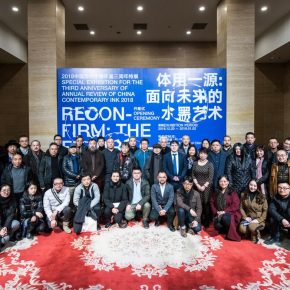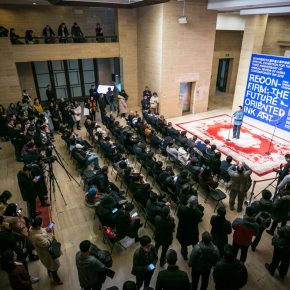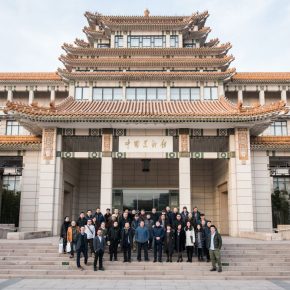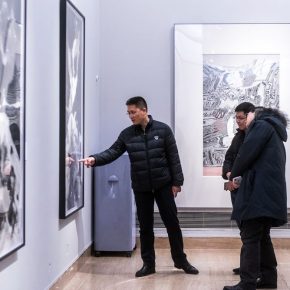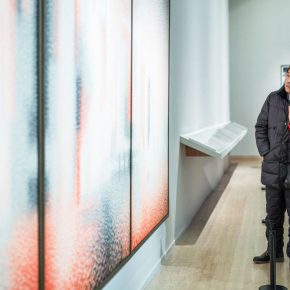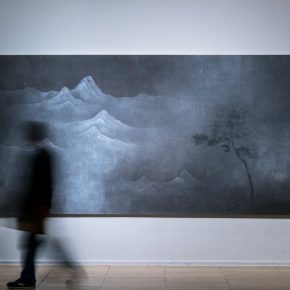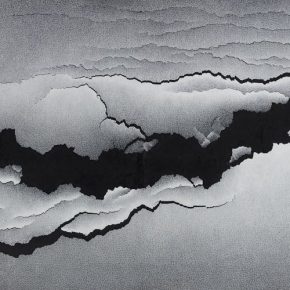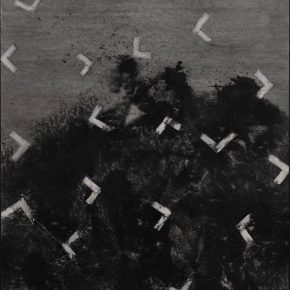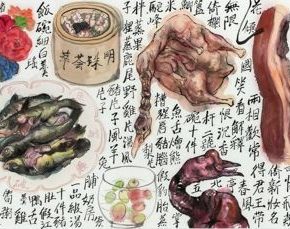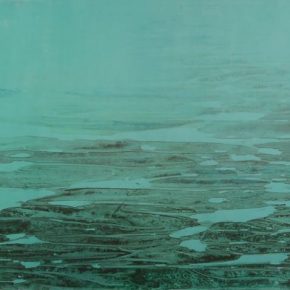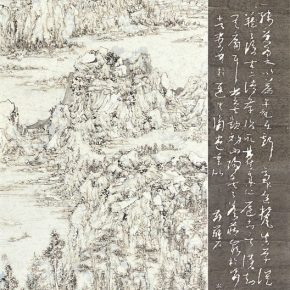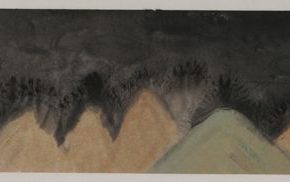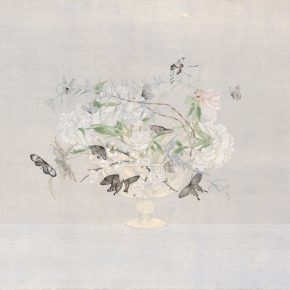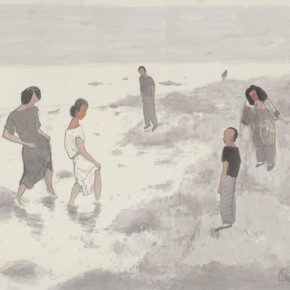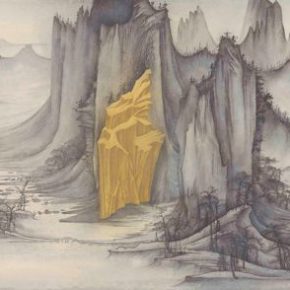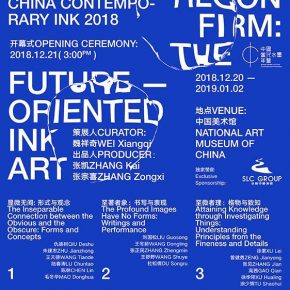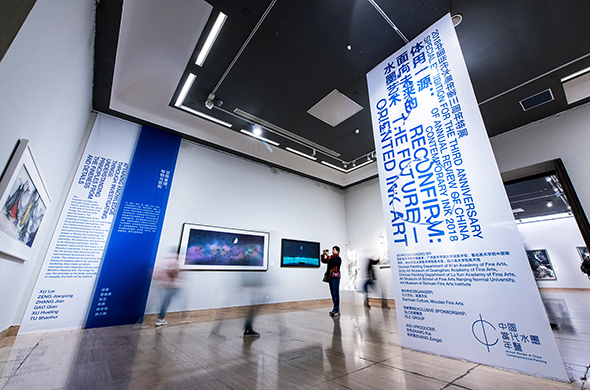
Special Exhibition for?the Third Anniversary of the Annual Review of China Contemporary Ink 2018?was launched at the National Art Museum of China?on December 21, 2018. It was jointly hosted by the Department of Chinese Painting at Xi’an Academy of Fine Arts,?UCITY Art Museum of GAFA, the School of Chinese Painting?at?LuXun Academy of Fine Arts and?the Art Museum of the School of Fine Arts at Nanjing Normal University and the Art Museum of Sichuan Fine Arts Institute and organized by Dachuan Culture and Moudao Culture,?to feature more than 60 works by 35 representatives of ink artists who were active in the art circles in 2018, in order to review the ink artists who?have played a role in the construction of ideas and spiritual forms of contemporary Chinese ink wash painting. It is entitled “Reconfirm: The Future-Oriented Ink Art”, starting from a reflection on the historical situation of “Chinese learning for essence, and Western learning for application”, to look to the future. ? ? ? ?
Ink art is one of the oldest art forms in China?and has a history of thousands of years. When Chinese literati intervened ink wash painting was almost considered a form of?literati painting.?Many concepts such as spirit resonance, abstraction and specification, thick and thin, and white?space, which are applied?in ink wash painting, form the unique aesthetics experiences of China. No one is able to clearly tell the time of the birth of the concept of “ink wash painting”, people have learned that it was first recorded in the “Shanshui Jue (Theory of Landscape Painting)”?by Wang Wei in the Tang Dynasty, stating that “Ink Wash Painting is the top painting category, the use of artificial skills to reach the natural realm.”?And the term of “ink wash painting”?has been widely used in modern times and Xie Zhiliu systematically?used this concept?when he wrote the book of “Ink Wash Painting” in 1957.?From modern times,?it has been the first time to discuss cultural value of ink art during the period of “the western civilization taking over the east”, with this happening at?the beginning of the last century. When western paintings?poured into China, Chinese people’s understanding of painted art changed or was reshaped, and then a concept of “Chinese painting”?appeared.?When Chinese contemporary art flourished?in the 1980s, there was a discussion on ink wash painting again,?the trend being to rethink the change in artistic concept.?Accompanied by the dispute about the concepts of “ink wash painting” and “Chinese painting” which?led to?new forms such as “experimental ink wash painting”, “new?ink wash painting”, and “contemporary ink wash painting”. This is also the?present cultural situation, and the artists also think of ink wash painting and face the future.
Looking forward to the future does not mean?viewing in isolation, but?to have?a rethink after looking back. When “Reconfirm: The Future-Oriented Ink Art”?is presented at the National Art Museum of China, “Flourishing Painting Circles of Jinling—Paintings from Nanjing in the Seventeenth Century”?also displayed many traditional ink wash paintings in the same space. Many painters gathered in the Nanjing area in the 17th century, such as Dong Qichang,?Kun Can, and Shi Tao who once traveled to Nanjing and painted, in addition to the “Eight?Masters in Jinling”. Painters from Jinling reflected on the “Four Wangs”?dominating?the mainstream painting?circles at that time, to break the fixed programs?of landscape painting created by the Four Wangs, to present a?noble and unsullied?disposition, and to make life full of vitality, leading to a?peak in the history of Chinese ink wash?painting.?Only by learning?from?the past and the present can people better face the future, so that the “Flourishing Painting Circles of Jinling—Paintings from Nanjing in the Seventeenth Century”?becomes?a starting point to visit the “Reconfirm: The Future-Oriented Ink Art”?for the spectators.
“Essence and application are unified”?is?a philosophical proposition put forward by Cheng Yi?in the Northern Song Dynasty. Cheng wrote a book entitled “Preface to the Theories of the Book of Changes”, stating that the invisible essence of things and the visible?phenomenon are unified.?Speaking of the?relationship?between “essence and application”,?we all know the phrase of “Chinese learning for essence, and Western learning for application”, which has been regarded as the rule of technology and culture chosen by Chinese governments and people since the drive towards Westernization. It emphasizes the?cultural subject identity?that has stretched for thousands of years,?and also it has constructed the?situation?of ink wash painting since the 20th century. Curator Wei Xiangqi said that, the exhibition?talked about the idea that “Essence and application are unified”?again, designed to reflect on the specifications of the traditional concept of?“essence and application”.?When an artist emphasizes his intuition, putting?aside the barriers in his mind, refusing to accept the differences?between essence and application, his or her art will directly impress?the spectator, reaching the source of art. Future-oriented ink art will inevitably return to the spiritual core and thinking of the art?noumenon, showcasing?the ideological form shared by all people and the world, and then it?can enter the historical process of contemporary ink art. To break?the dualistic?structure?of “essence and application”, as postmodern philosophy broke the metaphysics?emphasizing the dualistic structure,?it?is then capable of releasing new power, and it?is also conducive to promoting the modernization and contemporary transformation of Chinese ink?art.
“Reconfirm”?is composed of six parts including “The Inseparable Connection between the Obvious and the Obscure: Forms and Concepts”, “The Profound Images Have No Forms: Writings and Performance”, “Attaining Knowledge through Investigating Things: Understanding Principles from the Fine qualities and Details”, “Changing Different Ways of Doing Things According to the Changing Circumstances: Conversant with Things of the Past and Present”, “Magnanimous and Open-minded under any Circumstances when Realizing the Principles: The Historical Space”, “Understanding Everything when Realizing the Principles: Fables and Abnormal Phenomena”. Some of those works response to traditional brush and ink problems, and?some are about the changes and transformations in the context?influenced by modern and contemporary art trends. It has broken the inherent traditional cultural order to varying degrees, and has also built a future-oriented, world-oriented new order of ink wash?painting. Some participating artists?also agreed with this idea. For example, Yuan Wu believes that this proposition and presentation enable the new ink art?to unrestrictedly inherit the tradition, to carry the consciousness of the times and the individual?pursuit, and Yuan believes that ink wash painting only needs a free expression, instead of adhering to traditional rules. Wang Xiaohui?believes that the exhibition uses?“Essence and application are unified”?to deeply observe and review the diversity of contemporary ink wash?painting, and?everything is possible?in the future. Xu Lei also said that the future-oriented?ink wash art must have an international vision, combined with inner feelings of the artists. At present, people should do the things?that ancient?people?find impossible to finish.
Annual Review of China Contemporary Ink 2018?is a lookout and a preparation for the future. The art of the future is world-wide, open and borderless, and the theory of “essence and application”?focuses?on cultural subjectivity, revealing the difference between the?self and the other, which will?fall into the dilemma of theory in future,?and also cover the?universal value of art. Therefore, as the exhibition emphasizes, future-oriented ink wash painting must be concerned?with the common issues?faced by all people. This macroscopic theoretical consciousness can constantly correct the deviations?happening in the process of seeing the self and world. To have a reflection on “Chinese learning for essence, and Western learning for application”, people?can return to consider?the spiritual core?of?art noumenon in future.
It is the third year to hold the Annual Review of China Contemporary Ink, the founder of?the Annual Review Zhang Kai said that he?has?witnessed the prosperity, the hustle and bustle, silence and revitalization of contemporary ink wash painting, and also?he?constantly reviewed the?present?development route of ink art and tested the?academic foundation?of contemporary ink art. ?Another founder and the producer?of?the Annual Review Zhang Zongxi said that contemporary ink?wash?painting has undergone 40 years?full?of tempering and baptisms along?with?the?reform and opening up, and it has been given a new artistic vitality. In future?it?will also become a new starting point for Chinese contemporary art. It is both a summary of contemporary ink wash painting in 2018 and an expectation?in?2019?and it continues to?January 2, 2019.
Text by Zhang Wenzhi, translated by Chen Peihua and edited by Sue/CAFA ART INFO
Photo by the?organizer ??
Special Exhibition for?the Third Anniversary of Annual Review of China Contemporary Ink 2018—Reconfirm: The Future-Oriented Ink Art ????
Curator: Wei Xiangqi
Producers: Zhang Kai,?Zhang Zongxi
Opening:?December 21, 2018?15:00
Duration: December 21, 2018 –?January 2, 2019
Venue: National Art Museum of China
Exclusive Sponsorship: SLC Group
Artists participating in the exhibition (in no particular order):
Qiu Deshu, Zhu Jianzhong, Wang Tiande, Lu Chuntao, Chen Lin, Mao Donghua, Liu Guosong, Wang Dongling, Zhang Zhengmin, Wang Shuye, Du Songru, Xu Lei, Zeng Jianyong, Zhang Jian, Gao Qian, Xu Hualing, Tu Shaohui, Li Jin, Wang Xiaohui,?Liu Xijie, Zhu Yamei, Du Xiaotong, Pan Wenxun, Chen Suping, Yuan Wu, Xing Qingren, Feng Bin, Wang Jinsong, Wu Yi, Liu Zijian, Zuo Zhengyao, Li Yanbo, Wei Qingji, Zhang Wei, Wang?Yu


